#i wish there were more portraits of her in spanish attire
Text
Explaining my artwork of Harrow as a crowned Nun

Look! She’s gorgeous
Let’s start at the beginning.
What is a crowned Nun?
For those of you that didn’t grew up with a heavy Spanish influence in your culture, let’s simplify it: Nuns wanted to be pictured in a rad way.

Nuns could be pictured that way on multiple occasions: when they joined their congregation, when they died or when they celebrated the anniversary of their ordaining. Since most of the time, their families would never see them again (several convents enforced seclusion) it was maybe a way to preserve their memory by commissioning a portrait. They always had several element in common, of course the first one was the crown, the “palm”, a figure allusive to Jesus Christ and in some cases they would be holding a candle.
Joining a congregation in the vice-reign of New Spain (Mexico) was a huge deal, particularly for the richer women. They would walk to the convent wearing their best garments and people would give them valuable objects in their way in (jewelry, flowers, expensive fabrics). However, they would have to take of everything and change into a modest and far more humble attire: the nun habits. As a way of leaving their old life behind.
Now:
Why Harrow as a Crowned Nun?
Because I can.
And I loooove religious art and iconography.
But also, Nuns are a very interesting element of catholic regime and the way Tamsyn Muir presents Harrow as a Nun is so interesting to me. In GtN, Silas says that the ninth was never supposed to exist, they were supposed to die away quietly as soon as the tomb was locked…but they didn’t. Instead they created a religion around the Locked Tomb.
Sort of like the cult around the one, the only, the most amazing Virgin Mary. In countries like mine, the Virgin Mary is a figurehead of the church, several people even claim they are not catholic, instead, they are “Maristas” (wish would translate to something like Marists I think). That’s because when Spain converted the natives they tried to associate saints with their gods, in my culture, we revere Mary so much because she is the mother.
So, why is Harrow (the Reverend Daughter of the Ninth House, leader of the Locked Tomb Cult, a Cult that was never supposed to exist) a Nun when Nuns are supposed to be married to Jesus? The son of God?
Now you see my train of thought, right?
Right?
Now, let us dive into the elements:
The crown
The most iconic part of crowned nuns is of course, the crown. Some theorize that the flower crown alludes to Saint Barbara, who wore a crown made of roses, however, the most accepted theory (and the one that aligns with conventual rituals) is that the crown symbolized victory. The priest ordaining the nun would hear her take her vows as a bride of Jesus Christ and would crown her “for eternity”, for the crown was a symbol of eternal glory. Most crowns were made of Roses and lilys that meant purity, in Spain particularly, Nun’s crowns were made entirely of roses.

Harrow is wearing a Crown made of several flowers (I’ll get to it) and in the crown can be read “I pray the tomb is shut…”, for the Crown represents the weight of the tomb keepers and the legacy of the ninth house. But I omitted the “forever” because our favorite goblin very much opened the tomb.
The flowers
Bear with me, because I just picked and chose the meaning I wanted for the flowers. I do not stick to one culture and book, but I think that's more fun. On her crown, Harrow Is wearing five different flowers and laurel leaves.

Carnation: In Catholicism, Carnation represents martyrdom. The red color is associated with the blood of Jesus and his sacrifice for humanity. Harrow is wearing a flower that symbolizes the blood of the child of god (Jod). In a way, everything ends and behind with that blood.
Cempasúchil (Marigold): In Mexico, we use Cempasúchil to guide our dead back on the Day of the Death. It’s a flower associated with death and return. Obviously, I felt it was very fitting for a necromancer in a death cult.
Lily: Several saints and martyrs are pictured with white Lilys, that simbolize purity and virginity. I feel it's important to remember that Harrow died a virgin. I kind of want to rub it in her face. In a “no bitches?” way.
Forget me not: I’m sure you already figured it out, but these flowers represent Harrow’s mental state all throughout HtN. To me, these are Gideon’s flowers. Like Gideon asking and fighting to be remembered.
Baby’s breath: Notice a pattern? I tried to put as much of baby’s breath as I could. Since Harrow represents the sacrifice of two hundred children of the ninth. A weight Pelleamena and Priamhark placed on her shoulders, when they stole two hundred “baby’s breath” to conceive Harrow.
Laurel: Laurel represents victory. Heroes, athletes, etc. wear laurel leaves. One of the most distinctive elements of Jod is his crown. Laurel represents Harrow’s (bittersweet) victory and her association to Jod as a Saint.
The Palm (?)
Palms, like the crown, were a symbol of victory: The triumphant entering of Jesus in Jerusalem, the triumph over death from martyrs, you name it.
It truly doesn't look like a Palm, but it's very much like the palms these Nuns were pictured with. These palms initially looked like ordinary palms from palm trees. However, these nuns lived in barroque times, so a simple palm wasn't enough. Soon they were so ornated that they didn't looked like palms.
Harrow’s palm has the same flowers as her Crown. But I added one more flower: a Lily of the valley. Like a normal lily, it also symbolizes purity, but it can also represent tears. Kind of emphasizing how much our girl has suffered and needs a break (don’t give her a break Tamsyn, I’m terrified of what you can do)

Did you noticed something? A Hollywood hair Barbie perhaps?
Nuns were often pictured holding a representation of the saint they were devoting themselves to. I added Alecto because the whole Locked Tomb Cult revolves around her, and there's no one more devoted to Eldritch Barbie than Harrow.
If you reached this point, thanks!
Baby Jesus Gideon
Crowned nuns were mostly pictured with Jesus, normally as a baby or in the cross. Jesus is after all their “Holly Husband”. I decided to be self indulgent and add Gideon as Harrow’s Holy Wife (manifesting a kiss), and obviously because Gideon is the child of Jod. I drew her as a baby, because I truly didn't want to draw her impaled (the equivalent of her cross?).

So yeah, that’s it. A lot of rambles from my catholic past and my girl kisser present. I really invite you to check my sources (if you understand Spanish) because they are so interesting. I’m sure I missed so much.
Thesis on crowned nuns (I couldn't add it as a hyperlink, sorry) http://132.248.9.195/pdtestdf/0312151/Index.html
A chronic of Crowned Nuns and conventual life
Showcase of Crowned Nuns (many cool pictures)
Pictures from the exposition on Crowned Nuns from Museo del Virreinato
#the locked tomb#harrowhark my beloved#harrowhark fanart#harrowhark nonagesimus#harrow the first#alecto the ninth#gideon the ninth#artists on tumblr#catholic references#sacred art#nun#barroque
5 notes
·
View notes
Text
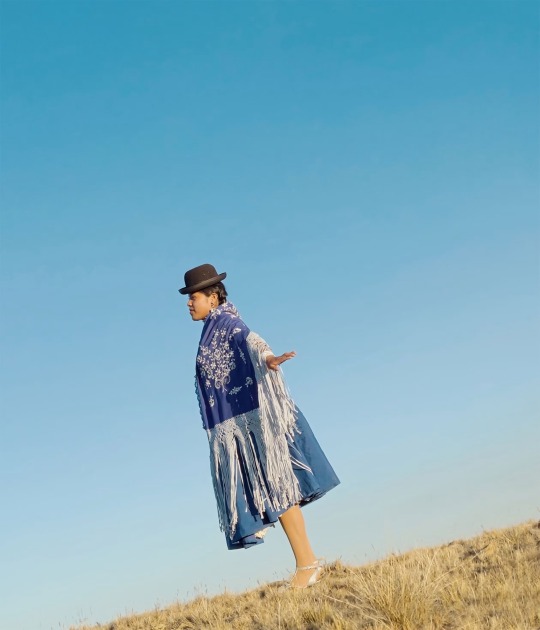
Noelia, a 19-year-old wrestler, poses for a photograph in her traditional cholita garb. Photograph By Luisa Dörr
Meet The Women Wrestling Their Way To Equality in the High Andes
Bolivia's stylish Flying Cholitas have merged modern wrestling with their community's history of activism.
— By Laurence Butet-Roch | Photographs By Luisa Dörr | August 30, 2018
“People need heroes, wrestlers, champions of their own who can be admired,” reflects Brazilian photographer Luisa Dörr, who spent ten days in El Alto, Bolivia, with a unique group of female wrestlers known as the Flying Cholitas. Recognizable by their colorful and elegant attire of multilayered skirts, embroidered shawls, and precarious bowler hats, cholitas emerged at the turn of the millennium—an expression of the indigenous renaissance taking hold in the Americas.
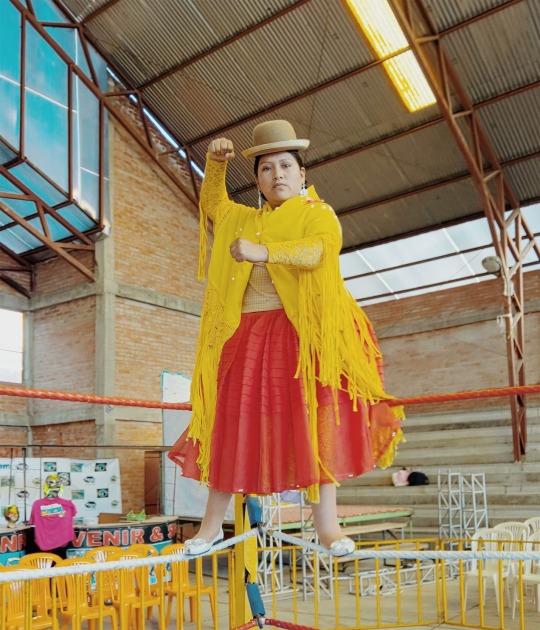
Angela, a single mother who uses her wrestling money to pay for her son's education, says, "People need some reason to fight, and mine is my son." Her 12-year-old son comes to watch all of her matches.
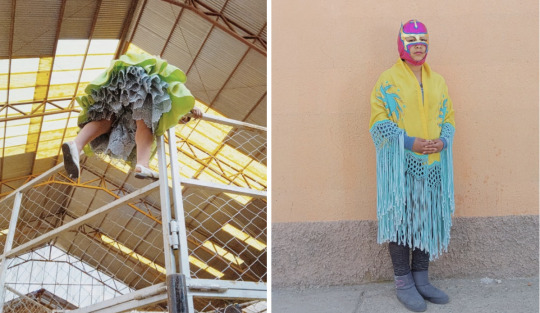
Left: Once a year in El Alto, Bolivia, wrestlers take part in a large-scale mixed-gender fight. Anyone wishing to escape the fight must jump the fence around the ring, and the last person inside is the winner. Right: Wara, a 19-year-old wrestler, says, "Thanks to wrestling, I have traveled to many places in Bolivia. For us, this is our profession."
Dörr, who likens them to Hollywood superheroes capable of flying, first encountered the wrestlers while her husband was working with local architect Freddy Mamani. She recalls attending Sunday matches at the community’s multifunctional center: “It's been a long time since I stopped liking the men's fights. They're the same as ever, but the Cholitas are the ones that save the show. The younger audience members identify with the good heroines, while the older ones prefer the rougher ones,” she says.
The Cholitas train twice a week and watch YouTube videos of Lucha Mexicana to improve their techniques and tricks. “The fight, more than anything, is a constant update of maneuvers. It's like riding a bicycle; if you learn to walk, you never forget. But if you want do tricks, you need to practice. The fight is the same. An eternal learning," explains Claudina, whose father, brother, and sister also wrestle.

Claudina, a Flying Cholita, comes from a family of wrestlers. She says, "My father was a fighter. My brother is a fighter. My sister is a fighter. I am a fighter."
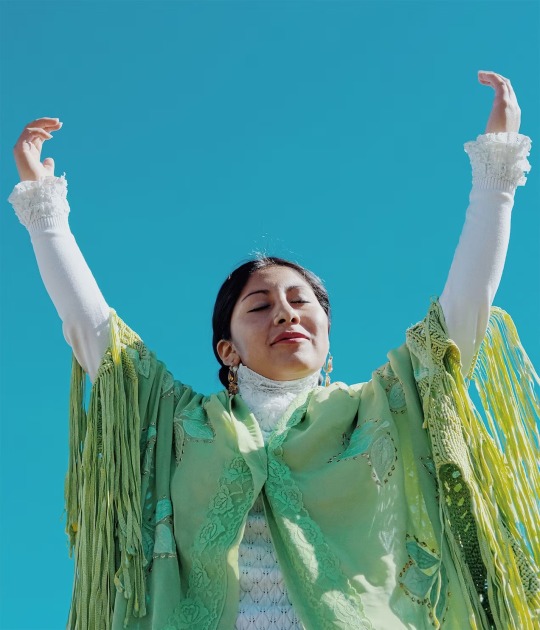
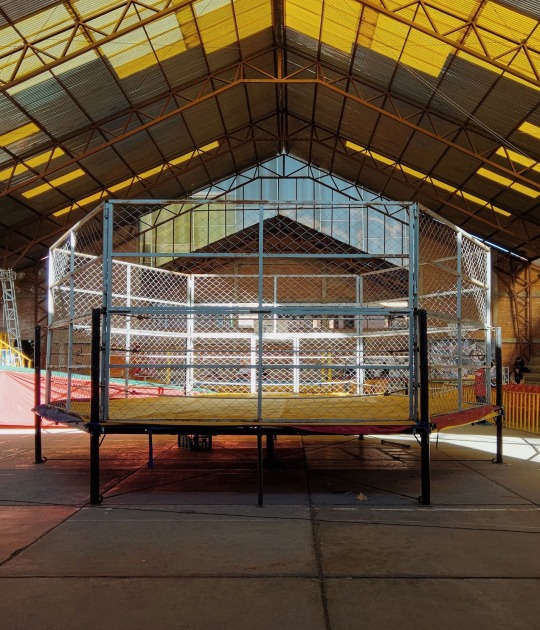
Left: Wara, 19, raises her hands in the air as her portrait is taken. Right: The ring at the Dolores de El Alto Sports Center is surrounded by a fence—and, during matches, by cheering, shouting, and jeering fans.
And the better they get, the more they can assert their presence in a field dominated by men. At times, both genders are even pinned against one another. "When a woman fights 100 percent, men want to fight 1,000 percent. They do not accept that they are overcome. In our companions, there are also some anti-Cholas,” says Mary Llanos Saenz, known as Juanita La Cariñosa in the ring, who’s been fighting for almost 20 years. “In the beginning, we were not allowed to enter the men's room. We used to change in the stands and wait outside. That's why we created the Association of Fighting Cholitas. There, men do not get involved.”
Monica, a friend and social worker in the community, was Dörr’s way in. “[The Cholitas] don’t really care about journalists and fancy magazines,” Dörr remarks. “Many of them were not interested with wasting time with a photographer on a story they will not ever read.” Their attitude toward media is at least partly fueled by the fact that the cholitas have much more urgent concerns than becoming famous. For centuries, they’ve also been fighting outside the ring to protect the well-being of their community.
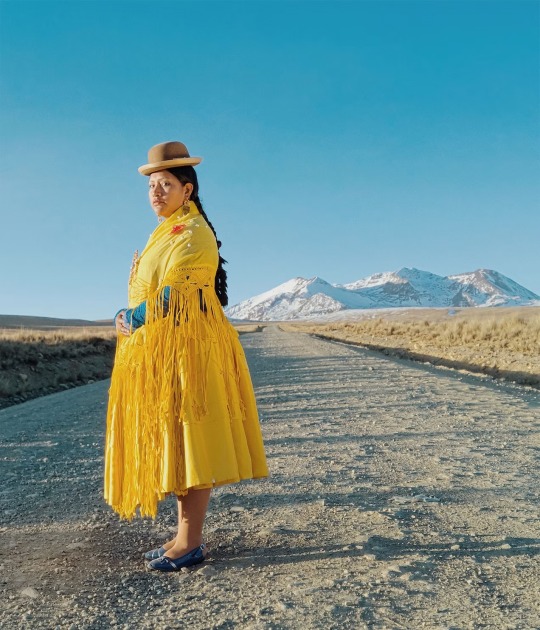
Angela, like many Flying Cholitas, is a single mother. Others have partners who are also wrestlers.
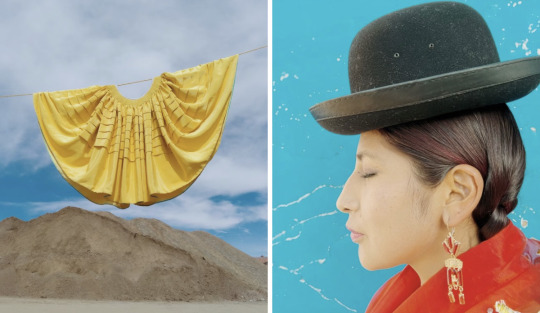
Left: The voluminous skirts women in Bolivia were forced to wear by Spanish settlers for centuries are now symbols of identity and pride. Right: Sonia, who owns a beauty salon, says, "Sometimes we get hurt and we have to stop [fighting] for a few months. I already broke my wrist, but I never had any injuries that would impede me [from fighting or working] again."
Most cholita wrestlers are Aymara, an indigenous nation residing in the high plains of South America. The group has faced ethnic oppression and exploitation since the Spanish colonization of the region. Referred to pejoratively as “cholo” or “chola” at the time, they were forced to perform menial tasks for aristocrats; required to adopt European customs; refused entry to restaurants, public transportation, and certain wealthy neighborhoods; and denied the opportunity to vote, own land, and learn to read.
Resilient, the community organized, leading several successful movements over many decades, the latest of which was the ousting of President Gonzalo Sanchez de Lozada—currently facing charges for extrajudicial killings—and the election of an Aymara politician, Evo Morales, to the country’s highest office. In the process, they’ve reclaimed the once-pejorative name and style of dress, turning both into symbols of pride.
“When El Alto gets angry with the state, because they have neglected their schools, their health centers, or their markets, or because of the absence of security in the neighborhoods, it is the women who go out and demonstrate,” explains Dörr. “And therein lies the essence, the reason why people enjoy watching and admiring the Cholitas fight, because it is the dramatization of the Chola Aymara woman from El Alto.”
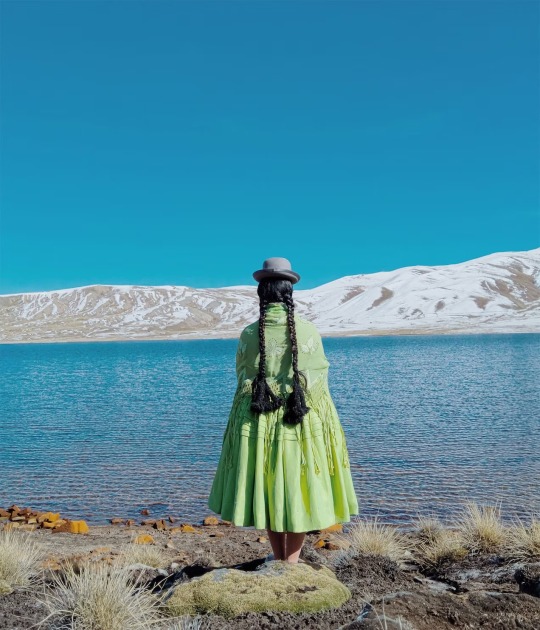
When many members of Bolivia's indigenous community were forced to work as servants for Spanish occupiers, they were made to wear a particular set of garments. Some of these items, including voluminous skirts and bowler hats, are now symbols of pride for cholitas.
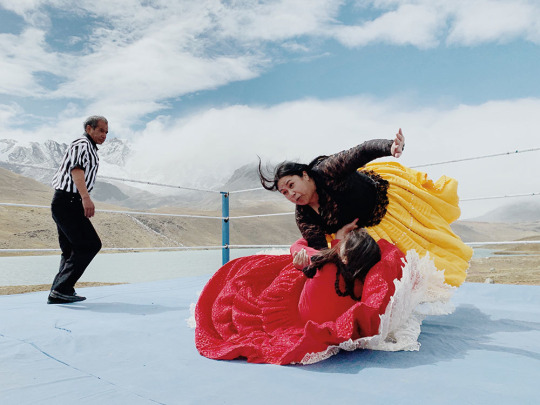
— Luisa Dörr is a Brazilian photographer based in Bahia, Brazil.
1 note
·
View note